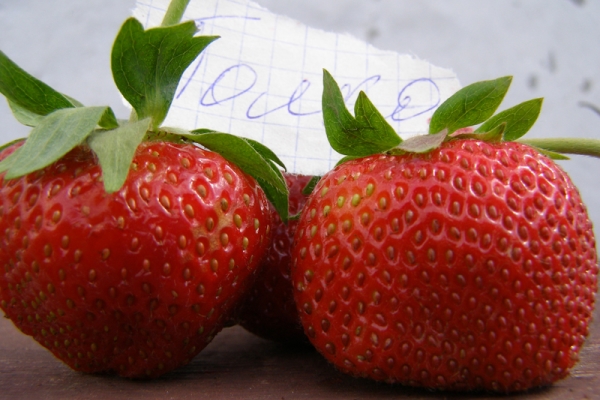Dutch Strawberry Shelf previously occupied one of the leading positions in the European market. It gives a harvest of large berries with good taste, which tolerate transportation and are stored for a long time. Today the variety is not as popular in industrial cultivation, but he was not forgotten by farmers and gardeners.
Table of contents
The origin, description and characteristics of the variety
The original name of the strawberry Shelf - Fragaria Polka. The variety was bred by Dutch breeders in 1977, crossing the varieties Unduka and Sivetta.
It is readily grown in small and medium production, in open ground and in greenhouse conditions.
Polka bushes are formed by strong shoots and large leaves. These are vigorous plants with a developed root system that can reach a height of half a meter.
Berries Shelves at the beginning of fruiting weigh up to 50 grams, the subsequent fruits are half the size. The shape of the berries resembles a blunt shortened cone with a scarlet glossy surface.
According to the description, the pulp has a dense texture of uneven red color. The skin is thin, but durable - does not stain the hands when touched.
Berries Shelves have a pleasant aroma and sweet taste with caramel notes. The fruit stem is separated from the fruit with effort.
Bushes produce many antennae, so they need to be cut in time to prevent depletion of planting and loss of part of the crop.

The shape and color of the berries does not suffer from heat treatment.. Therefore, jams and compotes are distinguished by a rich burgundy color. When drying fruits, the taste is not only preserved, but becomes more pronounced.
Advantages and disadvantages
The advantages of shelves gardeners include:
- frost resistance - strawberries do not suffer from frost, but to survive the winter without loss, you will need shelter;
- unpretentiousness - does not take a lot of forces at cultivation;
- universality in use - suitable for all types of processing, including industrial;
- it is well stored and without loss transfers transportation;
- resistance to diseases and pests, prevention is still required.
Of the minuses Shelves can be noted:
- the rapid degeneration of the bushes - after two years, the berry becomes shallow, therefore, it is necessary to transfer plants to a new place;
- during drought, the taste suffers the weight and quality of fruits, although the variety is claimed to be drought resistant;
- tall bushes grow rapidly, so regular pruning is required.
Shelf yields good yields as in the open beds, and under the film cover. With the observance of the rules of agricultural technology with one square meter can be collected up to one and a half kilograms of berries.

Strawberry Agronomy
Strawberry Polk can not be called demanding, but to obtain high-quality harvest is required to comply with certain rules of agricultural technology.
It must be remembered that this variety should be provided with shelter in the snowless winters, as well as protect the root system, which is most vulnerable to diseases.
Features of planting and care
Under the landing of strawberries Shelf need to highlight a well-lit area. Preparation of beds includes digging and removal of weeds, as well as enrichment of the soil with minerals, manure or humus.
Care process for strawberries includes the observance of simple techniques:
- Soil should have a weak acid reaction.
- Plants should be planted from August to September.
- The interval between the bushes should be at least 40 cm.
- The first feeding should be carried out in the spring.
- During the fruiting period strawberries should be fed with potash fertilizers, chicken manure or wood ash.
- Watering strawberries begin in April. Events are held every week until autumn.In the autumn, watering should be halved. For watering is better to use the drip system.
- Irrigation procedures are preferably carried out in the evening and use warm water.
When digging the area should be made 6-7 kilograms of manure and 50 grams of mineral fertilizer per square meter. Preparation of beds should be carried out 2 weeks before the start of planting.
The shelf can be planted in springtime, but the first fruiting will come no earlier than a year later.
After harvest Plantations should be cleaned from damaged and diseased leaves, treated from parasites and diseases, and organic and mineral fertilizers should be applied.
In snowless winters, the shelf should be covered with sawdust, spruce or special material.
To obtain an earlier harvest for the winter film tunnels are constructed. This method accelerates the ripening of berries for 2-3 weeks.
Transplanting strawberries Shelf should be carried out in spring or autumn. And when grown in greenhouses, the procedure can be carried out in the winter.
Planting strawberries in spring:
Breeding methods
Shelf strawberries are propagated by rooting aerial shoots (antennae) and dividing the bush (with horns).
Antennal rooting
Mother plants must be at least 1-2 years old, do not have signs of diseases and damage by pests, as well as give stable yields of large berries.
The process of growing and rooting outlets is as follows:
- young sockets tightly pressed to the ground, not taking away from the parent bush. To facilitate the process of subsequent transplantation, you can stick a plastic cup filled with primer under each outlet;
- By the end of July, young plants will take root and grow strong roots. At this time, strawberries can be transplanted to a permanent place, carefully separated from the mother bushes.
By winter, strawberries will have time to build up a good green mass, which will serve as additional warming.
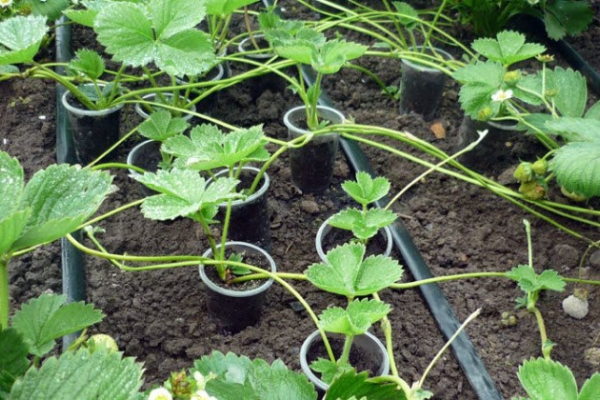
Division bush
For this method choose healthy three-year bushes:
- the procedure is carried out at the beginning of spring or after harvesting;
- remove all flower stalks from a bush;
- plants are carefully dug and cleaned from dried leaves and excess soil;
- To facilitate the process of dividing the roots can be placed in the water, where they will be cleaned and straightened;
- Shrubs are divided into several parts with a sharp sterile knife. On each fragment there should be a socket. The lower part of the roots are trimmed;
- plants are placed in a manganese solution for disinfection of sections;
- In spring, independent bushes are planted on prepared beds and covered with film for better rooting. In the autumn division, the fragments are cleaned from most of the leaves and old roots, and then placed in a refrigerator until spring.
When the plants in the garden will go to spring growth, ready seedlings can be planted in a permanent place.
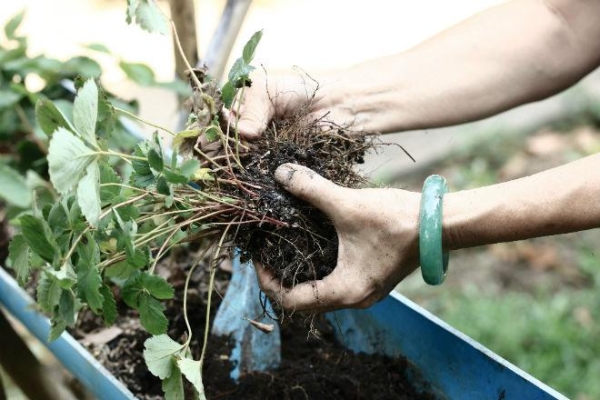
Diseases and pests
The shelf has a strong immunity to most diseases, but often suffers from diseases of the root system and is affected by verticillus.
Gray rot
Damages plants in the conditions of the increased humidity and can destroy up to 80% of landings. Manifests a disease of putrid-mold stains on the berries.
The leaves are covered with fast-growing spots of gray-brown color. All parts of the plant quickly dry out and the strawberry dies.
As a preventive measure:
- should follow the rules of crop rotation;
- keep fit clean;
- timely remove dry leaves;
- mulch between rows before fruiting;
- process the plantation with a solution of Bordeaux liquid before the growing season;
- after harvesting, spray the insecticide solution.
When infected plantings should be cleaned from damaged plants and processed planting special chemicals. If necessary, transplant healthy shrubs.
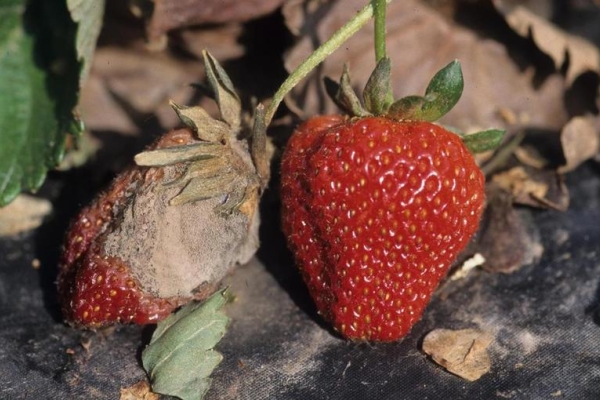
Verticillosis
The disease causes fungusaffecting the vascular system of plants, which leads to wilting and death of the plant.
The first signs of the disease appear on the external condition of the bush. He has an unhealthy look and stops growing. Later, the leaves begin to lie on the ground, and the plant looks sluggish.
And if the foliage acquires a yellowish color with a pink tinge, then saving the strawberries is no longer possible.
Prophylaxis disease serves the destruction of weeds on plantations and the treatment of soil with insecticides, as well as compliance with the rules of agricultural engineering.
When infected, strawberry plantations are treated with fungicidal preparations, after removing heavily infected bushes.
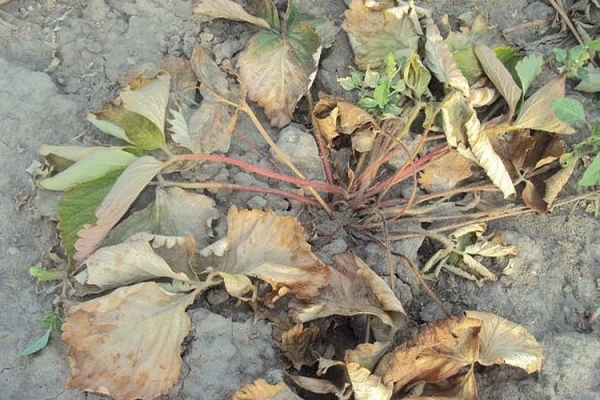
Shelf does not shine abundant harvest, but does not require special care. It is quite predictable - it will not burn in the summer heat, and survive the winter cold with minimal preparation.
Shelf also gives stable yields of berries with high taste and quality.
